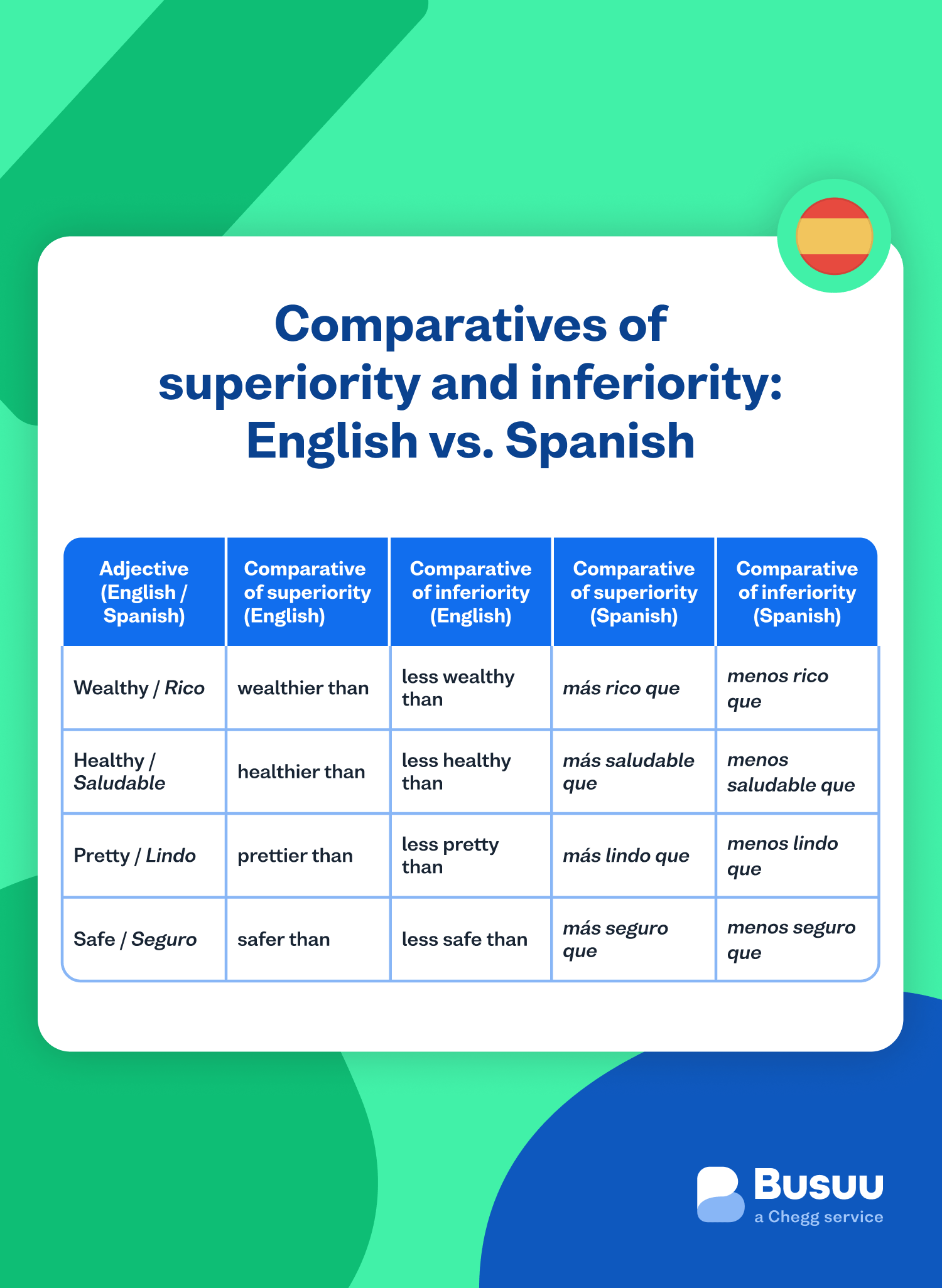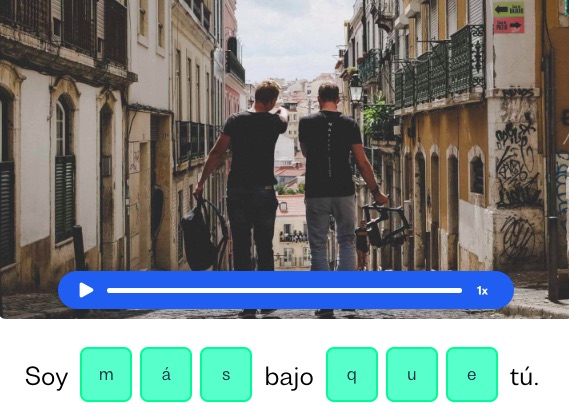When and Where to Use Spanish Comparatives
Learning Spanish comparatives is not hard. Keep reading to learn all about them.
I want to learn...
Spanish comparatives, like the word says, are used to compare an object or subject to another or others. We use them to describe when someone or something is more, less, or equal to someone or something else.
For example, when you want to say someone is younger, older, or as big as someone else, you can use this formula: Name (subject) + verb + more or less or as + adjective in comparative degree + than or as + something or someone else.
Let’s dive deeper and get down to the nitty-gritty of comparatives in Spanish so you will be able to learn how to use them!
Spanish comparatives: How many forms are there?
In Spanish, we use the comparative of superiority, inferiority and equality to compare two or more objects or subjects.
The comparative of superiority is built with the adverb más (more) + adjective, adverb or noun + que (than).
Similarly, the comparative of inferiority is built with the adverb menos (less) + adjective, adverb, noun + que (than).
The basic formula to remember is this:
- menos = que
- más = que
See some examples below:
- Belén es más alta que Jazmín. (Belén is taller than Jazmín)
- Toto es menos problemático que Felipe. (Toto is less problematic than Felipe)
- Diego es más rápido que el resto del equipo. (Diego is faster than the rest of the team.)
The comparative of equality is built with tan + adjective / adverb + como.
See some examples below:
- Belén es tan alta como Jazmín. (Belén is as tall as Jazmín)
- Toto es tan problemático como Felipe. (Toto is as problematic as Felipe).
- Diego es tan rápido como el resto del grupo. (Diego is as fast as the rest of the group).
In the comparative of superiority and inferiority in English, you add -er to the end of the adjectives to describe the “level or quality” of the adjective (“more” or “less”) ”. In Spanish you simply add “más + adjective + que” or “menos + adjective + que” before the adjective to describe the upper or lower end of said adjective.
In English, some adjectives are irregular. Generally, the long ones don’t accept the -er ending, like for example “beautiful”, so instead, we use “more beautiful than” or “less beautiful than”.

Comparatives of superiority and inferiority: English vs. Spanish
| Adjective (English / Spanish) | Comparative of superiority (English) | Comparative of inferiority (English) | Comparative of superiority (Spanish) | Comparative of inferiority (Spanish) |
|---|---|---|---|---|
| Wealthy / Rico | wealthier than | less wealthy than | más rico que | menos rico que |
| Healthy / Saludable | healthier than | less healthy than | más saludable que | menos saludable que |
| Pretty / Lindo | prettier than | less pretty than | más lindo que | menos lindo que |
| Safe / Seguro | safer than | less safe than | más seguro que | menos seguro que |
Let’s use these examples in sentences:
-
Mi tía Catalina es más rica que sus hermanas. (My aunt Calatina is richer than her sisters)
-
Ese hombre es menos rico que su padre. (That man is less rich than his father)
-
Las verduras son más saludables que la comida basura. (Vegetables are healthier than junk food.)
-
Los dulces son menos saludables que la fruta. (Sweets are less healthy than fruit.)
-
En mi país el sur es más bonito que el norte. (The South is prettier than the North in my country.)
-
Ese vestido es menos bonito que el azul. (That dress is less pretty than the blue one.)
-
Esa ciudad es más segura que la anterior en la que vivías. (That city is safer than the previous one where you lived.)
-
Los suburbios son menos seguros que el campo. (The suburbs are less safe than the countryside.)
In English, we use a comparative of superiority to indicate the upper level of an adjective. We change the ending of the word with -ier or -er, and add “than” to compare it to something else. And we use the comparative of inferiority to indicate the lower level of an adjective. In this case, we add “less + unchanged adjective / adverb”.
Irregular comparatives of superiority and inferiority
We talked about how in English we have irregular adjectives that don’t adopt the -ier or -er ending. Equally, there are some adjectives in Spanish that don’t accept the comparative of superiority and inferiority “más” or “menos” in all situations.
In Spanish, we don’t say "más bueno/a" but mejor.
For example:
- Esa escuela es mejor que la otra. (That school is better than the other one)
Similarly, instead of "más malo/a", we say peor.
For example:
- La comida en ese restaurante es peor que la de la escuela. (The food at that restaurant is worse than the one at school)
Note: We can use the regular comparative “más bueno” or “más malo” if we’re making a moral statement about someone in the colloquial speech.
Equally, when we talk about age or quantities, we usually don’t say más grande, but mayor. And, in the same sense, we use menor instead of más pequeño.
Examples:
- Mi amiga es mayor que yo. (My friend is older than me.)
- Cincuenta es menor que cien. (Fifty is lower than a hundred.)
Note: Again, in colloquial speech, we can say, “Mi hermano es más grande/más pequeño que yo” to talk about age.
Lastly, we have another two similar cases: inferior (in.feˈɾioɾ) and superior (su.peˈɾioɾ), which are written exactly the same as the English equivalents “inferior” and “superior”, but are pronounced differently.
Examples:
- La calificación de Juan es inferior a la media. (Juan’s score is below average.)
- Ese muchacho no es tan inteligente como tu hijo. (That boy is as smart as yours).
Spanish comparatives with verbs, adverbs or nouns
Aside from adjectives, comparatives in Spanish can also be formed with other types of words, such as verbs, adverbs and nouns.
Below are some examples:
- La cita tomó más de lo que pensaba. (The appointment took longer than I thought.)
- Ella corre más rápido que tú. (She runs faster than you.)
- Mis hermanas tienen más carteras que yo. (My sisters have more purses than me.)
Spanish comparatives: Recap
Spanish comparatives of superiority and inferiority are formed with the words más / menos when indicating something is less or more than something else que and the comparatives of equality are formed with tan / como when indicating something is of equal value.
We hope these examples were easy to understand and that you feel confident using Spanish comparatives from now on, but don’t hesitate to join the community and ask questions if you have any. And feel free to browse our blog for more helpful tips to fast track your Spanish learning experience!
Remember it’s easier to learn when you practice a lot and that’s what Busuu is here for!
Why stop learning now? Keep the momentum going!
You have done an amazing job in learning Spanish comparatives! But why stop here? Build that momentum and practice your Spanish with Busuu’s free online courses and learning resources today!

